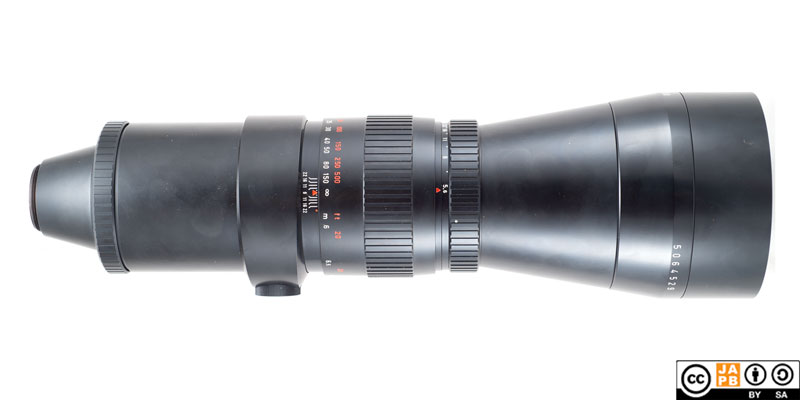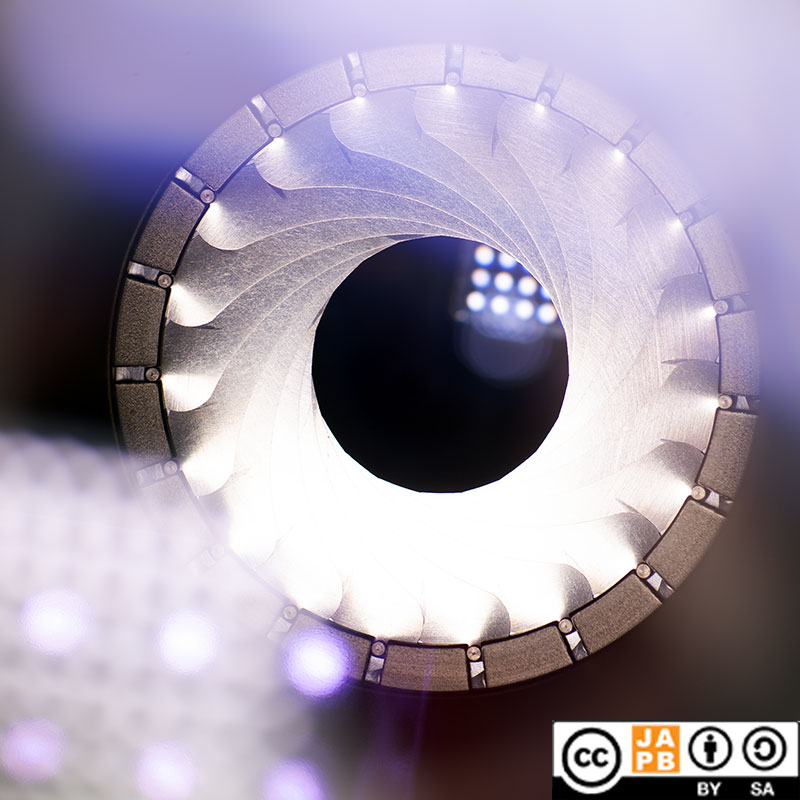Pekka Buttler, 04/2024 (Updated 08/2025)

Specifications
The table below summarises the lens’ key specifications (measurements based on above pictured sample):
| Brand: | Pentacon | Lens name | 5.6/500 |
| Focal length(s)1 | 500 mm | Angle-of-view2 | 5 ° (on full frame) 10° (on medium format) |
| Maximum Aperture | f/5.6 | In Production | 1965-1990 (all versions) |
| Lens mount (this lens) | M42 | Other lens mounts | Exakta, Pentacon Six, Praktina, Praktica B, T2 |
| Length3 | 431 mm | Diameter4 | 125 mm |
| Filter ring diameter | 118 mm | Weight | 3430 grams |
| Lens element count | 4 | Lens group count | 4 |
| Aperture blades (S/R/C)5 | 19 | Focus throw | 330 ° |
| Minimum focusing distance | 6 m | Maximum magnification | 1:≈10 |
| Has manual aperture ring | YES | Has Manual focus ring | YES |
| Aperture mechanism type | Preset | Aperture click stops | None |
Further notes:
• This lens was produced over 35 years, and under that time it had many names (rough production dates in parentheses):
– Meyer-Optik Görlitz Orestegor 500 mm f/5.6 (late 60s)
– Pentaconar6 500 mm f/5.6 (early 70s)
– Pentacon 500 mm f/5.6 (early 70s–mid 80s)
– Pentacon Prakticar 500 mm f/5.6 (late 80s)
– Meyer-Optik7 500 mm f/5.6 (early 90s)
• All versions (Meyer-Optik Görlitz/Pentaconar/Pentacon/Prakticar/Meyer-Optik) of this 500/5.6 were preset aperture lenses featuring an aperture range of f/5.6–f/22 and a 19-blade aperture mechanism. The Preset mechanism could be set on a half-stop interval between f/5.6 and f/22.
• This data sheet addresses the Pentacon 500 mm f/5.6 lens but specifications for the Meyer-Optik Görlitz Orestegor 500/5.6 and Pentacon Prakticar 500/5.6 are almost identical.

• Alike many tele lenses designed in the 1960s by Meyer-Optik Görlitz, the Pentacon 500/5.6 used Meyer-Optik’s proprietary interchangeable mount system, and was therefore theoretically usable on a wide range of cameras:
– the initial Meyer-Optik Orestegon 500/5.6 as well as the early Pentacon 500/5.6 lenses could be purchased with a mount for either Exakta, M42, Pentacon Six or Praktina mount cameras
– from roughly the early 80s, the lens was also offered with mounts for the Praktica B mount.
– for a short while in the 1990s, you could also buy the lens with a T2 mount.
– because the interchangeable mount parts are relatively simple, any competent machinist is able to produce a mount for any full frame (or smaller) camera mounts, while some medium format (film mounts) are impractical due to adverse flange focal distance differences.
• This lens is something of an oddity, because it seems it was primarily designed as a long tele lens for the Medium Format Praktisix (later ‘Pentacon Six’) camera. The requirement for being able to comfortably cover medium format film (≈80 mm diagonally) has been defining for the designing of the lens. Hence, for use on full-frame or 35 mm film, the lens is somewhat over engineered.
Versions
This lens remained in production for ≈35 years. During that time, no changes to the basic optical recipe were made, but in the mid 70s lens elements started receiving multi coating. Your lens will have multicoating, if:
– its name sports the MC acronym.
– it is branded as ‘Prakticar’
– if it is branded ‘MEYER-OPTIK’, in all caps (Not ‘Meyer-Optik Görlitz’)
During that 35 year production period, some cosmetic/ergonomic changes also happened:
– the focus ring patterning changed, first from a ridges and valleys type to the lengthwise ribbed pattern (pictured above); then the lengthwise ribbing elongated to broaden the focus ring grip.
– similarly, the initial aperture ring featured a very narrow ribbing, but that changed to the design pictured above.
– the colour of the feet scale was changed from orange-red (as pictured) to green.
• While by no means rare, this was never a high-volume lens. Hence, it’s quite possible to find lenses that combine barrel parts across variations.
History of Pentacon
Pentacon – more precisely VEB Pentacon – was an East German state-owned camera and optics combinate that was very influential (also outside the East Bloc) from its inception until the demise of the East German people’s republic.
But Pentacon was not born out of thin air. Therefore any real appreciation of Pentacon – either as a camera maker or as an optics manufacturer – has to start with a back story. Read more in the JAPB company profile on Pentacon …
Adapting
(Here we will discuss adapting this lens on the assumption that you have a version sporting the M42 mount piece. If you have another mount, look up the JAPB article on that mount)
This lens cannot be used natively on any current SLR or dSLRs. To use it in its native environment, you will need an m42-mount film body. Luckily there are a lot of those available and in working order.
Thanks to being a fully manual lens (manual aperture, manual focus), the lens can be adapted to all mirrorless cameras using a suitable adapter. Moreover, m42 lenses are so uncomplicated that a simple ‘dumb adapter’ will do the job perfectly. Further, due to the popularity of the m42 mount, special adapters (helicoid adapters, tilt/shift adapters) are readily available. Alternatively, one can choose to daisy-chain adapters (e.g. m42->Canon EF; Canon EF –> mirrorless) which also opens up a wide range of speed boosters .
Using m42 lenses on dSLRs can also be an easy option, depending on which dSLR.
• Canon EF has the shortest flange focal distance among full-frame dSLR’s and Canon’s wide range of dSLRs are able to mount m42 lenses perfectly, using a simple adapter ring.
• Minolta / Sony A dSLRs and Pentax dSLRs are likewise able to mount m42 lenses using a simple adapter ring.
• Nikon F dSLRs have a long flange focal distance, meaning that mounting M42 lenses needs an adapter that uses corrective optics to allow anything close to infinity focus.
Footnotes
.
- Focal length is (unless stated otherwise) given in absolute terms, and not in Full-frame equivalent. For an understanding of whether the lens is wide/tele, see ‘Angle-of-view’. ↩︎
- Picture angle is given in degrees (based on manufacturers’ specs) and concerns the diagonal picture angle. Rule of thumb:
> 90 ° ==> Ultra-wide-angle
70–90 ° ==> Wide-angle
50–70 ° ==> Moderate wide-angle
40–50 ° ==> ‘Standard’ or ‘normal’ lens
20–40 ° ==> Short tele lens
10-20 ° ==> Tele lens
5-10 ° ==> Long tele lens
< 5 ° ==> Ultra-tele lens ↩︎ - Length of lenses is USUALLY given on JAPB from the mount flange to the front of lens at infinity. However, as I was unable to unscrew this lens’ shortish lens hood, the number includes the lens hood. ↩︎
- Diameter excludes protrusions such as rabbit ears or stop-down levers. ↩︎
- S=straight; R=rounded; C=(almost)circular at all apertures. ↩︎
- During the period right after VEB Pentacon took over the lens catalogue of Meyer-Optik Görlitz, it would seem the new masters were not entirely sure how to name the new ‘Pentacon’ lenses. As a result, some early post-merger lenses left the factory sporting the name ‘Pentaconar’. ↩︎
- After the fall of the German Democratic Republic, the lens was even briefly offered under the resurrected Meyer-Optik name, at this time even an adapter ring to the T2-mount (42 mm threads with 0.76 thread pitch and 55 mm FFD) was included to broaden the lens’ appeal on then current systems. ↩︎